

Uploading files to the Appery.io database. What are we going to build?

In this tutorial, you’ll learn how to build a mobile app that uploads files to the Appery.io database. It’ll be an HTML5 app that uses a browser File API (different from the Appery.io Database File API). The File API is supported by most desktop browsers. However, if you want to run this app in a mobile browser, you’ll need to install the Firefox Mobile or Opera Mobile browser. Note: You can find more information about which browsers support the File API via the link. The app will look like: Before you begin Tutorial level: advanced.Prerequisites: completed at least 1 beginner and 1 other advanced tutorial. Creating new app Create a new app; from the Apps page, enter UploadingFilesApp for the name and click “Create.” Building an app with a password recovery feature. What are we going to build?
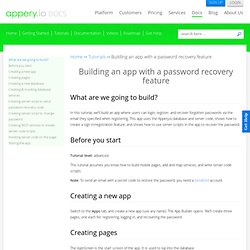
In this tutorial, we’ll build an app where users can login, register, and recover forgotten passwords via the email they specified when registering. Creating Microblog App Using OpenAM Server Integration. What are we going to build?
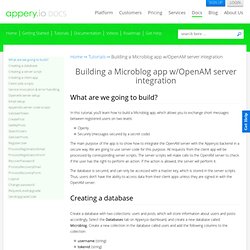
In this tutorial, you’ll learn how to build a Microblog app, which allows you to exchange short messages between registered users on two levels: Getting started with custom app logic. Introduction Server code allows you to write custom app code using JavaScript that runs (executes) on the Appery.io server.
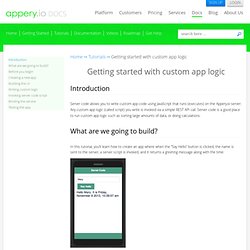
Any custom app logic (called script) you write is invoked via a simple REST API call. Server code is a good place to run custom app logic such as sorting large amounts of data, or doing calculations. REST Services. Introduction You can use REST services to integrate with back-end cloud services that support a RESTful API.
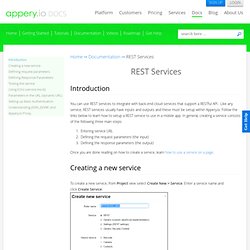
Like any service, REST services usually have inputs and outputs and these must be setup within Appery.io. Follow the links below to learn how to setup a REST service to use in a mobile app. In general, creating a service consists of the following three main steps: Entering service URLDefining the request parameters (the input)Defining the response parameters (the output) JavaScript API. Appery.io comes with a small JavaScript library to make it easier to select elements in the DOM.
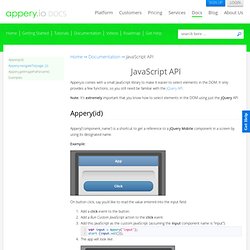
It only provides a few functions, so you still need be familiar with the jQuery API. Note: It’s extremely important that you know how to select elements in the DOM using just the jQuery API. Appery(id) Source Editing Tutorial. What are we going to build?
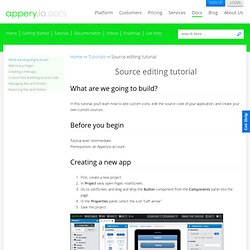
In this tutorial, you’ll learn how to add custom icons, edit the source code of your application, and create your own custom sources. Building a clickable list app with HTML5 local storage. What are we going to build?
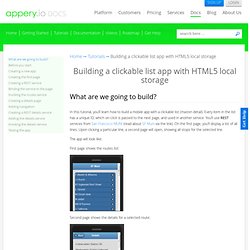
In this tutorial, you’ll learn how to build a mobile app with a clickable list (master-detail). Every item in the list has a unique ID, which on-click is passed to the next page, and used in another service. You’ll use REST services from San Francisco MUNI (read about SF Muni via the link). On the first page, you’ll display a list of all lines. Upon clicking a particular line, a second page will open, showing all stops for the selected line. Building a dynamic select menu. What are we going to build?

In this tutorial, you’ll learn how to build a dynamic select menu. It contains two drop-down lists. The second drop-down list depends on the value selected in the first drop-down. Working with events and actions. Introduction When building a mobile web app, almost everything that happens in your app is based around events.
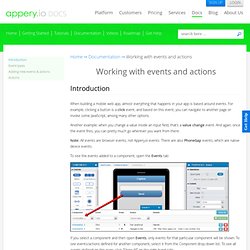
For example, clicking a button is a click event, and based on this event, you can navigate to another page or invoke some JavaScript, among many other options. Another example; when you change a value inside an input field, that’s a value change event. And again, once the event fires, you can pretty much go wherever you want from there. Note: All events are browser events, not Appery.io events. Show Password checkbox. I have found that the above solution does not work very consistently. Here is what I am now actually using, which has been tested on an Android phone (the above was not tested on a phone). This assumes the input component for your password is named "password" and is a password type. Working with databases. Database collections When you open the database, a Collections view opens.
Here you can do the following: create and import collections;edit the collection (add and delete columns and rows), change the permissions and delete the collections;see REST APIs for every collection, including the predefined collections;add users and set passwords in the Users collection;upload and download files in the Files collection;add devices with installed apps in the Devices collection. Predefined collections There are three predefined collections in every database: Users data;Files data;Devices data. Building a ToDo app, pt. 2: offline mode.